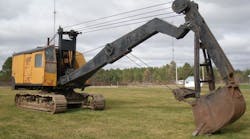The excavator is a joint collaboration between the Association of Equipment Manufacturers (AEM), National Fluid Power Association (NFPA), Center for Compact and Efficient Fluid Power (CCEFP) from the National Science Foundation (NSF), and the U.S. Department of Energy’s Oak Ridge National Laboratory (ORNL).
The project is still in progress as the group enlists help from two separate research teams of graduate engineering students at Georgia Tech and the University of Minnesota. The Georgia Tech team will brainstorm new designs for the boom and bucket, while the Minnesota team designs the hydraulic oil reservoir, heat exchanger, and cooling system. Both teams expect to improve efficiency and decrease the weight and size of the excavator.
The group also invites any interested party of engineering students to design a streamlined cab and human-machine interface. Designs can be submitted through the Center for Compact and Efficient Fluid Power’s website, and a cash prize of $2000 will be awarded to the team with the best 3D-printed design. On top of that, the team will win a trip to Tennessee to print their design at the ORNL.




